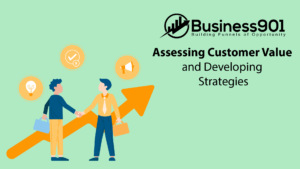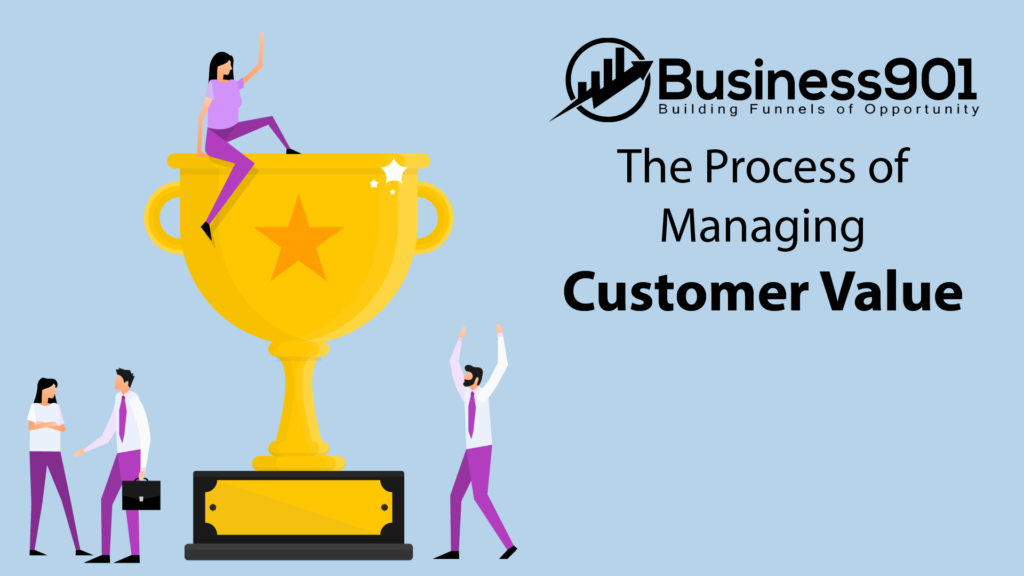The ability to create, maintain and maximize customer value is an essential ingredient in the success of any business. A successful customer value initiative is identifying, developing, and managing the relationships between customers and an organization. It helps organizations build a strong customer base and ultimately increase profits.
 Implementing a customer value initiative is important in aligning your company around customer value as a core strategy. To maximize customer value, companies must invest in understanding their customers, create relevant and engaging experiences, and build a relationship that reflects the value exchange between their brand and the customer. A customer value initiative is a strategic effort to proactively manage customer relationships and maximize customer value by utilizing customer data, personalizing the customer experience, optimizing customer service, and providing loyalty rewards. You will receive a few benefits from implementing a Customer value initiative.
Implementing a customer value initiative is important in aligning your company around customer value as a core strategy. To maximize customer value, companies must invest in understanding their customers, create relevant and engaging experiences, and build a relationship that reflects the value exchange between their brand and the customer. A customer value initiative is a strategic effort to proactively manage customer relationships and maximize customer value by utilizing customer data, personalizing the customer experience, optimizing customer service, and providing loyalty rewards. You will receive a few benefits from implementing a Customer value initiative.
-
- Aligning the company around customer value as a core strategy helps to ensure that the company’s goals and values align with the customer’s needs and expectations. This can help to build a strong relationship, loyalty, and trust between the brand and the customer.
- Utilizing customer data will help to gain a better understanding of the customer and enable the company to create tailored experiences that provide value to customers.
- Optimizing customer service with a customer value initiative will help to increase customer satisfaction and reduce customer complaints.
- Providing loyalty rewards will help further build relationships with customers and encourage them to continue engaging with the brand.
Measure Performance Against Competitors
It is important to measure organizational performance against competitors to identify areas of strength and weaknesses. Developing a customer value program enables businesses to measure their performance against other organizations accurately. Establish a clear definition of customer value and KPIs such as loyalty, satisfaction, and NPS scores to measure performance accurately.
Benchmarking against existing industry leaders can help paint an accurate picture of where the business lies in relation to the competition. Utilizing a range of primary research methodologies, such as surveys and focus groups, could help uncover insights into customer needs, which can further orient strategies around increasing customer value. Collecting relevant financial data, including net margins, cost per acquisition, fiscal efficiency ratios, etc., will allow organizations to monitor their progress over time and make informed decisions by providing valid comparisons with competitor offerings and pricing models. With these findings, businesses can evaluate their digital presence and marketing initiatives with competitors at home and abroad, effectively measuring performance within the digitally charged landscape we live in.
Market Research Framework
Market research is essential when developing a customer value program as it enables you to identify your target market’s specific needs and preferences. A market research framework can help you gather valuable insights and develop a comprehensive program that meets the requirements of your target customers.
 The first step in the process is determining what type of information your business needs to develop its customer value program effectively. Your research should cover customer demographics, purchase habits, preferences regarding pricing models, product features, and user experience.
The first step in the process is determining what type of information your business needs to develop its customer value program effectively. Your research should cover customer demographics, purchase habits, preferences regarding pricing models, product features, and user experience.
Next, decide on a data collection methodology that best fits your needs, such as surveys or focus groups. Once the data is collected from interviews, questionnaires, or observations, analyze it using tools such as business intelligence software or statistical methods to reveal insightful conclusions about your target audience.
After implementing the customer value program, you must develop frameworks for tracking results. This includes analyzing sales and marketing performance data, customer satisfaction ratings, and more to evaluate how well the program has met its objectives. Utilize these findings appropriately to make appropriate improvements and adjustments over time.
Identify Marketing Strategies
A marketing strategy is a vital part of developing a customer value program. Identifying the appropriate marketing strategies will depend on an understanding of customer needs and preferences as well as the goals of the organization. Effective marketing strategies are essential for reaching target audiences and maintaining customer loyalty.
Marketing strategies should focus on short-term and long-term objectives, allowing businesses to maximize their resources while providing customer value. Common strategies include advertising, public relations, personal selling, direct mail, online marketing, and trade shows. Each strategy requires careful planning to reach its intended audience efficiently and effectively.
Moreover, businesses can leverage data analytics to better inform their marketing decisions/strategies by understanding consumer behavior and preferences to develop tailored messaging campaigns. Additionally, businesses can incorporate referral programs or other incentives into their marketing plans to encourage customer engagement and loyalty-building activities, such as referrals from existing customers or discounts for returning customers. Through proper implementation of data analytics, businesses may also assess which tactics are most effective for particular markets to ensure the greatest return on investment when developing a customer value program.
Develop Relationship Marketing
 Developing a customer value program allows businesses to build customer relationships and promote customer loyalty. Relationships are formed by providing customers with value through rewards, discounts, and preferential services. Furthermore, relationship marketing allows businesses to proactively strengthen their competitive edge by understanding their customers’ needs and developing strategies to address them.
Developing a customer value program allows businesses to build customer relationships and promote customer loyalty. Relationships are formed by providing customers with value through rewards, discounts, and preferential services. Furthermore, relationship marketing allows businesses to proactively strengthen their competitive edge by understanding their customers’ needs and developing strategies to address them.
The key benefits of developing relationship marketing strategies include the following:
-
- Establishing loyalty to increase customer satisfaction, retention, and referrals for new business.
- Creating positive associations between offered services/products and unique brand messaging.
- Understanding customer buying behaviors through focus groups and surveys.
- Generating personal connections with customers by engaging them in conversations about their experiences with products/services.
- Analyzing internal data to identify opportunities for growth
Implementing incentive programs such as membership discounts, coupons, etc., that reward those who support the brand regularly.
New Product Go-To-Market Framework
A customer value program can help businesses consistently leverage customer insights and feedback to deliver improved products and services. The goal is to develop a comprehensive plan that outlines the process for designing, launching, and measuring the effectiveness of the new product or service offering. A well-thought-out customer value program should include four key components:
-
- Identifying Customer Insights: The most successful product launches are based on deep customer insights, so businesses must take the time to understand their target customers, their needs, and what motivates them towards a specific solution. Doing so will ensure you have an effective go-to-market strategy tailored specifically to your customer base.
- Establishing Funding Parameters: Businesses need insight into their financial constraints when creating new products or services to understand what they can comfortably invest in the project. Without setting these parameters in advance, projects could run over budget due to unbudgeted expenses or shifting requirements throughout development cycles.
- Designing Pilot Programs: A pilot program allows teams to test an idea’s marketability without having to commit large investments initially, allowing companies ample opportunity for refinements before expanding into a larger deployment process. Pilots should be designed with measurable criteria so that performance can be tracked and successes can be evaluated accurately against alternative solutions being tested simultaneously, if applicable.
- Developing Measurement Metrics: Nothing is as valuable as learning from real customer experience while launching a new product or service — it’s just not always possible when trying out ideas at scale quickly. Having measurable metrics in place helps businesses get more accurate information on their initiatives while also providing opportunities for continuous optimizations throughout the program launch process and beyond -helping maximize returns on investment over time
Develop a Customer Database around Customer Value
Creating a customer database is the most important step to implementing a successful customer value program. This data should provide an organized, comprehensive catalog of information about your customers. Great customer value requires comprehensive understanding at the individual customer level—developing an accurate view of your customers and their needs relative to your services or products.
To begin, identify only those customers you need to understand to make decisions and prioritize activities. Common criteria for selecting target customers include year-over-year spending growth or changes, value amount thresholds, size or type of organization, or purchases made over an extended period of time. After creating the pool of customers, you want to analyze and collect detailed information about them. This could include name and contact info, lifetime sales data, annual revenues/revenues by segment, areas of business focus, and buying patterns, including what they prefer and when they like to buy it.
Tracking this kind of data allows you to create characteristics profiles to define ideal customer segments on which you can focus efforts if needed to maximize ROI. They also allow you to assess who is most profitable by revealing the cost associated with serving certain types of customers versus rewards earned. It enables trends discovery which will aid in building models for customized win-win interactions with each customer segment, from price cuts tailored for non-loyal long-term buyers or exclusive offers for highly-valued VIPs that drive repeat purchases and referrals.
Sales and Marketing Alignment with what Customers Value
Developing a customer value program is designed to align sales and marketing goals with what customers value. It begins with understanding the wants and needs of the customer, including their perception of value and how to differentiate products and services from competitors. By taking the time to identify what matters to customers, creating a clear customer value proposition helps build stronger relationships based on established trust.
 When sales teams understand what differentiates the product or service offering from competitors, they can better meet customers’ demands by tailoring communication around their preferences. In addition, understanding current market needs and shifts that may occur over time enhances sales cycles for improved conversion rates. Effective communication also ensures that potential risks associated with a purchase decision are identified early to prevent costly misunderstandings or missteps.
When sales teams understand what differentiates the product or service offering from competitors, they can better meet customers’ demands by tailoring communication around their preferences. In addition, understanding current market needs and shifts that may occur over time enhances sales cycles for improved conversion rates. Effective communication also ensures that potential risks associated with a purchase decision are identified early to prevent costly misunderstandings or missteps.
This alignment between sales and marketing can also optimize product development plans by leveraging data-driven insights from customer surveys, interviews, and focus groups. This allows companies to continuously refine offerings based on customer feedback, strengthening loyalty amongst existing customers and attracting new ones. Studies have proven that organizations that invest more aggressively in understanding customers’ needs generate higher profits over time than those that primarily rely on short-term performance metrics such as cost-cutting or promotional campaigns alone. The power of developing an effective customer value program depends on continued dedication toward listening and responding appropriately to consumer feedback.
Techniques for Managing the Progress and Results of Customer Value Initiatives
Achieving positive customer value outcomes requires a comprehensive and well-defined program that includes continuous monitoring and evaluation. This begins with gathering customer feedback on existing products and services and measuring performance against stated objectives. Tracking customer loyalty metrics such as repeat purchases, referrals, and reviews is an important part of determining the success of value initiatives.
Effective management of the progress and results of a customer value initiative requires carefully planned tactics for evaluating performance, including:
-
- Developing appropriate Key Performance Indicators (KPIs). KPIs should measure progress against defined benchmarks and competencies.
- Organizing target-based campaigns to generate greater engagement with customers to identify improvement areas.
- Conduct regular surveys to identify areas where customers are satisfied and dissatisfied with current offerings.
- Analyzing the results of customer surveys to gather insights into new methods or strategies to optimize their experiences.
- Feedback loops that measure customer satisfaction within predetermined time frames allow them to provide feedback while engaged with your product or service.
- Analyzing analytics data from multiple channels, such as social media platforms, website visits, or app downloads, can help track user trends.
- Developing metrics that capture buying patterns, growth areas, and adjustments that should be made accordingly to increase customer value generation over time.
Cascading Customer Feedback within the organization
An effective customer value program can have pervasive effects on the organization. One such avenue is customer feedback to inform policy and practice change. This involves cascading customer data into the organizational departments responsible for implementing changes to ensure high customer service and satisfaction levels.
When implementing a customer value program, it is important to ensure clear pathways for customer feedback about their experience within an organization. This could be through surveys, weekly meetings, or other communication systems that solicit customers’ information about their needs and opinions. Once customer feedback is collected, further action should be taken to use this information to drive positive change within the organization.
Once customer data has been collected and analyzed, it should cascade down through the organization until all necessary individuals are aware of changes that need to be made or actions that must be taken to improve the customer experience. For example, suppose a certain process produces unsatisfactory outcomes for customers consistently. In that case, it may be necessary for changes in training or policy implementation within various departments to ensure better outcomes for customers in the future.
 In addition, another outcome of an effective program could include rewards programs offered by an organization and incentive plans developed on the ground with those most engaged with customers providing direct suggestions as to how best they can be treated. The increased transparency between employees at all levels of management ensures a nurturing culture throughout an organization whereby customer service standards are recognized as paramount by everyone who works there. It will also highlight potential areas where improvements can still be made to enhance the experience provided by companies offering products or services directly while still maintaining profitability, thus allowing them greater success both on and offline.
In addition, another outcome of an effective program could include rewards programs offered by an organization and incentive plans developed on the ground with those most engaged with customers providing direct suggestions as to how best they can be treated. The increased transparency between employees at all levels of management ensures a nurturing culture throughout an organization whereby customer service standards are recognized as paramount by everyone who works there. It will also highlight potential areas where improvements can still be made to enhance the experience provided by companies offering products or services directly while still maintaining profitability, thus allowing them greater success both on and offline.
Developing a Corporate Culture Around Customer Value
Developing a corporate culture around customer value is essential in helping an organization achieve its business goals and objectives. As the customer is becoming increasingly influential in shaping businesses, an effective value program should be geared towards building better relationships between the customer and the organization. To ensure this, organizations must clearly understand what their customers expect from them and strive to provide them with these.
Creating an internal culture that recognizes the importance of providing value to customers starts by engaging with employees across all levels of the workforce. Organizations can begin by introducing policies and procedures that help foster a mindset change within the organization to put customer satisfaction as a priority in their business model. This could include putting more focus on
-
- Providing quality products and services
- Investing in customer service training programs
- Improving customer feedback systems
- Introducing regular performance reviews with staff based on customer satisfaction scores
- Developing reward schemes and incentives for employees who demonstrate outstanding results in delivering on customer value expectations.
Having clear organizational processes that allow staff to access information about individual customers easily can further help build strong relationships between customers and organizations. Having access to the relevant information quickly and efficiently can improve response times for queries from customers or potential buyers, allowing the organization to anticipate their needs better. Introducing technology solutions such as CRM software systems can help facilitate this process and provide teams with greater visibility into individual customers’ needs, so they are better equipped to respond accordingly to deliver increased value for them. Additionally, leveraging data-driven insights about individual customers or groups of buyers through advanced analytics tools or frameworks can further help organizations tailor products or services more precisely toward what will best meet each individual’s needs.
How Business901 Works
THIS IS NOT A PASSIVE EXERCISE: It is a Learn-by-Doing Approach.
Managing customer value, or MCV, is an approach to managing customer relationships to create long-term customer loyalty and sustained customer value. This is not a passive exercise; it is a learn-by-doing approach to taking customer value to the next level. An effective MCV initiative is based on customer insight and analysis, gathering customer feedback to understand their needs, wants, and preferences. This information is used to develop strategies and tactics tailored to customer needs and wants.
Typically, an MCV initiative begins with defining the target customer and then identifying methods to measure customer value. Once customer value is measured, strategies such as customer segmentation, campaign management, and customer experience optimization are implemented. With each customer value cycle, data is gathered and analyzed to understand customer trends and behaviors. This data is then used to refine strategies, campaigns, and customer experiences.
An MCV initiative’s goal is to refine methods, data, and interpretation continuously and to understand deeper the learning developed in the cycle. This cycle-driven approach to understanding customer value helps organizations create more effective and tailored customer experiences that lead to increased customer loyalty and higher customer value over time.
The benefits of implementing an MCV strategy are numerous. It allows organizations to create personalized and tailored customer experiences, increase customer satisfaction and loyalty, and increase revenue. With an effective MCV strategy, organizations can optimize customer relationships, build customer loyalty, and create long-term customer value.
We act as Teachers, Consultants, Strategists, or Implementers
Implementing a Managing Customer Value initiative requires a team of experienced professionals who can act as teachers, consultants, strategists, and implementers. Business901 specializes in providing such services and can help you seamlessly transition into a successful new program.
As a teacher, Business901 can provide an educational platform to your team with virtual courses and on-site training. This will ensure that all team members are updated on the latest techniques and strategies for managing customer value. Business901 will also provide individualized consulting services and strategizing sessions, which can help you identify the best ways to implement the program.
When it comes time to implement the program, Business901 will act as your implementer. They have the necessary experience to ensure the program is implemented without disrupting your existing processes and resources. Business901 will provide you with dedicated teams of professionals who will work to ensure the implementation is completed most efficiently and cost-effectively.
The pros of using Business901 for your Managing Customer Value initiative are their experienced teams who will be dedicated to your project, their ability to provide training and individualized consulting services, and their ability to implement the program seamlessly. With their help, you can be sure that your new program will be successful and efficient.
Tools for Measuring Customer Value
Tools for measuring customer value are a great way to track and quantify the value of products and services. These tools measure the overall satisfaction and perceived value customers receive from a product or service and can inform companies how to manage customer value best. When combined with other customer value metrics, these tools can provide a comprehensive understanding of customer value which can then be used to make informed decisions about product and service offerings.
Value models are a popular tool for managing customer value. These models measure customer value by assessing the financial benefit and customer experience associated with a product or service. By understanding the customer’s needs and measuring the value they receive, companies can focus on providing value to customers in an effective way. This can help companies provide better services and ensure that they are creating value for their customers.
A competitive value matrix is another tool for measuring customer value. This tool compares customer value to competitive offerings and assesses how a company’s product or service stacks up to the competition. Through this assessment, companies can identify areas of strength and areas for improvement. By properly leveraging competitive value, companies can improve customer experience by offering competitive advantages, such as lower prices or better services.
If you want to align your company around Customer Value as a core strategy; you should implement a specific initiative to achieve this. Business901’s Managing Customer Value program enables you to implement the program effectively with minimal disruption to your existing processes and resources. It also gives you the skills required to manage that program effectively and becomes a strategic asset from which your customers and company will benefit. The program is designed around with specific milestones and time frames to meet your outcomes. A starting point:
- Designing and Developing Your Program
- Training and Educating Your Team
- Manage the Program’s Healthy Development
- Establish and Integrate a Customer Value program.
Please contact me on LinkedIn to arrange an introductory session about Customer Value.

